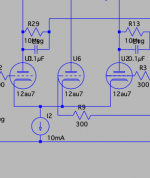I've been playing with a front end from TubeCad: Cathode-Follower OTL and SIT FETs
Specifically this:

The front end is interesting, the first triode simply puts the signal out via the cathode based on the cathode for bias. The second triode amplifies for the output stage and takes feedback directly from the output - reduced by a 27K resistor. The interesting bit is that it then causes the cathode to bias and thus auto-bias the first triode. (actually input noise will also go up to the B+ via the first and then have anti-phase through the second and output stages).
So.. this got me thinking... Long Tailed Pairs and differential amps and how the auto biasing of the cathode could be used but in a unique way - using three triodes in the LTP.

The first and last triodes provide the standard configuration, however a third (centre) triode is added simply to change the tied cathodes bias based on output feedback (rather than feeding into the grid of the second triode). This then almost replicates the original concept but for LTPs. Not new I suspect but still it seems to make it easier to manage negative feedback without messing with the phases.
Thoughts? (other than lunacy or why waste a triode)
Specifically this:

The front end is interesting, the first triode simply puts the signal out via the cathode based on the cathode for bias. The second triode amplifies for the output stage and takes feedback directly from the output - reduced by a 27K resistor. The interesting bit is that it then causes the cathode to bias and thus auto-bias the first triode. (actually input noise will also go up to the B+ via the first and then have anti-phase through the second and output stages).
So.. this got me thinking... Long Tailed Pairs and differential amps and how the auto biasing of the cathode could be used but in a unique way - using three triodes in the LTP.

The first and last triodes provide the standard configuration, however a third (centre) triode is added simply to change the tied cathodes bias based on output feedback (rather than feeding into the grid of the second triode). This then almost replicates the original concept but for LTPs. Not new I suspect but still it seems to make it easier to manage negative feedback without messing with the phases.
Thoughts? (other than lunacy or why waste a triode)
Last edited:
Now there are 3 grids to bias instead of two. The CCS does the auto-biasing for constant current draw.
Maybe useful for a balanced input with the N Fdbk on the 3rd grid. (except there is no phase association then, never mind)
Maybe useful for a balanced input with the N Fdbk on the 3rd grid. (except there is no phase association then, never mind)
Last edited:
Now there are 3 grids to bias instead of two. The CCS does the auto-biasing for constant current draw.
Maybe useful for a balanced input with the N Fdbk on the 3rd grid. (except there is no phase association then, never mind)
The CCS regulates max current true, with biasing node acting as a viable bypass it changes the voltage at which the cathode sits, just as using a LTP.
Phase - that's interesting bit, for two reasons - the coupling cap between the signal stages so all GNFB is ~90 out of phase.
The second is that if it's an AC signal vs a DC offset, it becomes more interesting (as I think you're alluding to). As you have two phases of output, the input is only one phase. And I think two options here:
a) use the final output - this has gone through two caps thus 180 out of phase from the input signal but combines both push-pull phases.
b) use a more complex scheme to essentially push pull the cathode - this could work if the push-pull is a dual class A (one B+ and one B-) and the pre-output cap signal paths are used to drive it. The danger is the changing resistance from the two LTP valves making oscillations possible and valve overload so a CCS is still required for safeguarding the valves. And down the complexity habit hole we go..